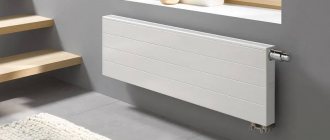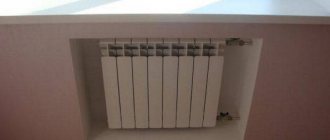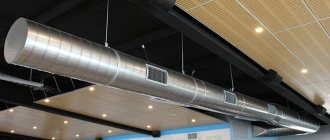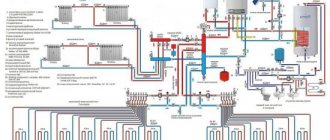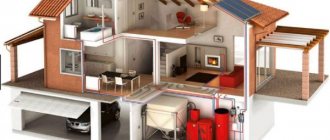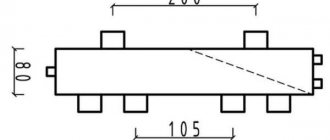Good day. If anyone doesn’t know, Stefania Volna advises and advises you. I am telling you my experience and knowledge in jurisprudence, which in total is more than 15 years, this makes it possible to give the correct answers to what may be necessary in various situations and now we will consider - Appendix D * (mandatory). If in your particular case you need an instant answer in your city or online, then, of course, it is better to get help on the website. Or it’s even easier to ask regular readers who have previously encountered the same question in the comments.
Attention please, the data may not be relevant at the time of reading, laws are updated and supplemented very quickly, so we look forward to your subscription to us on social media. networks so that you are aware of all updates.
If the number of floors is different in different parts of the building, as well as when the building is placed on a site with a slope, when the number of floors increases due to the slope, it is determined separately for each part of the building.
The area of multi-light premises, as well as the space between flights of stairs more than 1.5 m wide and openings in floors more than 36 m, as well as elevator and other shafts should be included in the total area of the building within only one floor.
Information about changes:
The total area of the building includes the following areas: mezzanines; galleries and balconies of auditoriums and other halls; verandas; external glazed loggias and galleries, as well as transitions to other buildings. The areas of any premises (including technical ones), regardless of the height of the surface above them, are included in the total area.
- The cost of the property for the buyer. An inexperienced person, when looking for housing, may mistakenly focus on the value of the OP. When choosing an option suitable for purchase, you should first of all concentrate on the size of the living space.
- Amount of heating payments. Utilities calculate based on total footage.
- The amount of contribution for major home repairs. The amount of payment for general building repairs directly depends on the square footage of the entire apartment of each specific owner.
- Comfort of living. The size of the living space has a direct impact on the comfortable living conditions of each person. But the OP is no less important, since it also includes other rooms that play an important role for the convenience of living (bathrooms, storage rooms, cabinets in niches, kitchen).
How to calculate the total area of an apartment is given below. This calculation is not difficult - you need to measure the area of all the rooms included in it and summarize the results. But there are some nuances that should be taken into account:
What doesn't turn on
- Residential premises (rooms). These are bedrooms, living rooms, children's rooms, where people sleep, work, relax - spend their leisure time at home.
- Kitchens. Regardless of the amount of time residents spend in the kitchen, this room is still classified as a household room and is included in the total area. Even if the owner decided to arrange a place to relax there and spends all his free time there, this does not affect the purpose of the kitchen.
- Corridors that connect the rooms inside the apartment with each other.
- Rooms for sanitary purposes (bathrooms, toilets) do not belong to living space. They are part of the overall footage.
- Wall closets also belong to the OP, despite the fact that residents, as a rule, do not go into them at all.
- Niches in the walls of Stalin-style houses designed for storing food in winter, instead of a refrigerator.
We recommend reading: How to Better Pay Rent Arrears to Bailiffs
If the share participation agreement does not contain a clause on a possible increase/decrease in the actual area, then the participant has the right to go to court with claims against the developer for the return of the overpaid amount. The court will calculate the amount of money taking into account the size of the total area of the apartment, calculated according to the rules of Art. 15 Housing Code of the Russian Federation.
In the case of reconstruction of a house with the eviction of the tenant, the landlord is obliged to provide the citizen and his family with another living space for the duration of the reconstruction. At the same time, the social rental agreement remains in force, and after reconstruction is completed, the tenant has the right to return to his previous housing (Article 88 of the Housing Code of the Russian Federation).
The concept of apartment living space
In contracts for shared participation in construction, there is another category - the designed area of residential premises, which may differ significantly from the total. When concluding contracts, it is necessary to take into account the norms of deviation from the total area of the residential premises and the procedure for increasing or decreasing the price for constructed housing.
- Without loggias with balconies, as if they were absent (even if in fact they are).
- Taking into account these premises, but their area is calculated according to coefficients. Accordingly, the total area coincides with the given one.
- Taking into account the dimensions of balconies/loggias in full size, that is, without coefficients.
Everything is natural, but you can’t live on a balcony or loggia, and they are not heated, so charging for them like full-fledged rooms is also wrong. Premises are assigned to a given area, which is calculated with special coefficients.
How does the total area differ from the one shown?
It is noteworthy that terraces, loggias and balconies are calculated using a reduced coefficient, since such premises are not residential, but common. At the same time, everyone understands that a balcony adds convenience. So why then should owners of apartments with loggias/balconies have the same utility bills as people without these additional amenities?
Due to the fact that the size of utilities depends on the area , it is necessary that the area in the documents corresponds to reality. Sometimes this requires ordering a new technical passport for the residential premises. Based on the data contained in it, a cadastral passport is drawn up, and information from it is indicated in the certificate of ownership.
Is the balcony area included in the total area of the apartment according to Russian law?
This fact must be known when purchasing/selling or re-registering residential real estate. When calculating the final total footage, the existence of balconies/loggias/terraces leads to an increase in the price of real estate, since it is calculated for each square meter. Living rooms include all premises suitable for living. All of these will need to be taken into account. Because otherwise, difficulties may arise with the Bureau of Technical Expertise. All technical documentation must be completed correctly - especially if there will be a sale of real estate in the future. Since buyers always pay especially close attention to this.
Arbitrage practice
If we consider the totality of all court decisions, it can be noted that the court often takes the side of home buyers. This happens because when applying to judicial authorities, buyers are guided by the Housing Code of the Russian Federation.
This gives them a greater advantage over developers who rely on building codes. Thus, at the slightest suspicion of error, it is necessary to boldly demand justice.
The current legislation clearly states what the concept of total footage of housing includes. Therefore, those who have carefully studied the document have no questions about whether the balcony is included in the total area of the apartment and when the protruding structures become part of the total residential area.
But do not forget that if the balcony is a living space and is fully heated, then it must be included in the calculation of utility bills. Otherwise, the court will side with the utility employees. And you will have to pay a fairly large sum of money - a fine for unauthorized behavior.
What is included in the total living area of the apartment?
According to the current rules for designating the total footage, the total area of your apartment must be understood as the result of the addition of all square meters of its heated and unheated rooms and premises, as well as those calculated using reducing indicators. An accurate understanding of how the reduction factor is used when calculating the square footage of individual premises will save you from misunderstandings and unpleasant surprises. If you were unable to protect yourself from such shortcomings, then only an appeal to the judicial authorities can restore justice.
Example No. 3
The common house appliance is completely absent. Payment for heat will be calculated using formulas No. 1 and No. 2.
Before calculating the heating in the apartment, using formula No. 1, the calculation will look like:
1.5 * 1400 = 2100 rubles
According to formula No. 2, the calculation will be made as follows:
0.025 * 75 * 1400 = 2625 rubles
For general house needs, the calculation will look like:
0.025 * 100 * 75 / 6,000 = 0.03125 Gcal
- 100 sq.m. – the area of premises that are included in the common property in the house.
How heating in an apartment is calculated in rubles is calculated using the following method:
0.03125 * 1,400 = 43.75 rubles.
After these calculations, you can calculate the heat payment for your apartment:
2,100 + 43.75 = 2,143.75 rub. – if there is an individual device in the apartment;
2,625 + 43.75 = 2,668.75 rub. – if there is no device.
Please note that if you have problems with heating in your apartment, and you simply don’t yet know how to install individual heating in your apartment, you should definitely contact specialists who will explain everything and help solve the problems. First, a heating project for the apartment is done. After its approval, you can proceed to the next step - purchase equipment and, perhaps, provide for such an option as additional heating of the apartment.
Before heating your apartment, you should think through everything carefully - not without the participation of professionals. And if you need heating repairs in your apartment, then the ideal option would be to contact a special service - since independent actions can harm not only you, but also those around you.
A heated loggia is included in the total area of the apartment
Sometimes the developer misleads participants in shared construction, claiming to buyers that he is guided by the housing legislation of the Russian Federation. For example, it imposes information on clients - buyers that certain additional rooms in the apartment do not belong to the living space, although this space is paid for when purchasing. The total area of an apartment should be considered (according to a certain article of legislation) the total amount of area of all the premises that are included in it. Additional premises that satisfy the needs of apartment residents are also taken into account when calculating the total area.
Heated area of the apartment according to the laws of the Russian Federation
Thus, a balcony is a fenced area protruding from the plane of the facade wall. May be glazed. A veranda is a glazed, unheated room attached to or built into a building that has no depth limitation. A loggia is a built-in or attached room, open to the outside space, fenced on three sides by walls (on two sides in case of a corner location) with a depth limited by the requirements of natural light in the room to the outer wall of which it adjoins. May be glazed. Based on the definition itself, it becomes clear that a balcony cannot be included in the total footage when calculating fees for heating services, for example, since according to the Rules for the provision of utility services dated May 23, 2006. The area of unheated premises is not taken into account when calculating the amount of charges. As for the “rent,” it is calculated in direct proportion to the square footage of the entire apartment, but for an apartment with a balcony, a reduction factor of 0.3 must be used.
21 Dec 2022 marketur 1889
Share this post
- Related Posts
- When will discounted air tickets to Crimea from Yekaterinburg be available?
- Assignment of the right to claim debt between legal entities
- Okof in 2022 monoblock
- Power of attorney to represent the interests of a physical person
What is included in the total area of an apartment in Russia in 2022
It is possible to calculate the full cost of real estate Correctly estimate the purchase price Drawing up an explication, technical passport for the apartment As well as other accompanying documents for real estate This parameter will be needed when selling In order to justify the value of real estate to a potential buyer When carrying out redevelopment You will need to make the calculation yourself
- object of housing rights;
- living space;
- apartment area;
- unsuitable for habitation;
- auxiliary premises.
Object of housing rights Premises that are recognized as residential. Accordingly, in order for an apartment to be recognized as a residential premises, it must have the main features of such and meet standard requirements. They are determined for each type of real estate. Apartment area. Standard parameter that is taken into account primarily when calculating the cost of housing. Unsuitable for habitation. The condition of the premises when it cannot be used for its intended purpose. Moreover, there must be a recognition as unsuitable in the standard manner established
Please note => About suspension or suspension as correct
Is the balcony included in the total area of the apartment?
3.37. The total area of the apartment is determined as the sum of the areas of its premises, built-in wardrobes, as well as the areas of loggias, balconies, verandas, terraces and cold storage rooms, calculated with the following reduction factors: for loggias - 0.5, for balconies and terraces - 0.3, for verandas and cold storage rooms - 1.0. The same is said in the mandatory Appendix No. 2 to SNiP 2.08.01-89. Paragraph 2 of the Appendix states “The total area of apartments should be determined as the sum of the areas of their premises, built-in wardrobes, as well as loggias, balconies, verandas, terraces and cold storage rooms, calculated with the following reduction factors: for loggias - 0.5, for balconies and terraces - 0.3, for verandas and cold storage rooms - 1.0.”
How to calculate heating correctly
As it turns out, it is not enough to just buy the right boiler; the correct selection and location of heating radiators in the premises is equally important. At the same time, it is not recommended to rely only on your instincts or the advice of friends. In other words, it is simply impossible to do without specific calculations of radiator sections per room.
Naturally, it is better if such technological calculations are carried out by specialists in this field, but this will require considerable financial costs from you. In this regard, many are wondering how to calculate the number of heating radiators per room on their own. You will need to take into account many important nuances. You may be surprised by the results, as the finished heating system will have a sufficient level of accuracy.
Heated area of the apartment according to the laws of the Russian Federation
In everyday life, any person may suddenly need to get an answer to the question of whether the balcony is included in the total area of the apartment. Ordinary people not involved in housing construction or the provision of real estate services hardly asked such a question without being faced with the need for clarification directly. According to clause 3.37 of the Instructions, the total area of an apartment is defined as the sum of the areas of its premises, built-in wardrobes, as well as the areas of loggias, balconies, verandas, terraces and cold storage rooms, calculated with the following reduction factors: for loggias - 0.5, for balconies and terraces - 0.3, for verandas and cold storerooms - 1.0.
What is included in the total area when calculating heating fees?
Svetlana! The rules for calculating the amount of payment for were approved by the Decree of the Government of the Russian Federation dated May 6, 2011. To calculate the size of the heating fee in your case, this is formula 3 of Appendix 2 of the above rules. But it is not clear what exactly you are not satisfied with in the management company’s response. The formula indicates that for the calculation, in your case, the area of residential premises, that is, apartments, is taken. The area of common areas is not used in the formula, but this does not mean that when distributing the volume of thermal energy that your house consumed in all rooms, you do not have to pay for heating that is consumed in common areas - entrances, staircases, etc. d. Hello! For the calculation, the area of residential premises in your case is taken, but it must be taken into account that your house has a common house meter installed, which reflects the readings of thermal energy consumed in all rooms of the house, that is, in apartments and common areas, therefore, despite the fact that Since the calculation formula only indicates the area of residential premises, in fact your heating payment will include the thermal energy consumed both in your apartment and part of the thermal energy consumed on inter-apartment landings, stairs and basements.
Please note => Discounts for students on public transport
Heated area of the apartment: was it calculated correctly?
The methodology for planning, accounting and calculating the cost of housing and communal services, approved by Decree of the State Construction Committee of the Russian Federation dated February 23, 1999 No. 9, explains that “to determine the heating fee per 1 square meter of housing, the area of an apartment or individual house is determined as the total the area of living rooms and utility rooms excluding loggias, balconies, verandas, terraces and cold storage rooms, vestibules.” How do you look at the above problem through the prism of the above link to the current regulatory legal document? I answer:
See the main answer above. Currently, the calculation of the heating fee is based on the total area of the living space. An exception is made only for balconies, loggias, verandas and terraces - their areas are not included in the total and heated area. The storage area, if it is included in the total area of the apartment according to the technical passport, will also be considered a heated area. However, if the pantry is divided between several owners, then they must pay the costs for it in proportion to the total area of their apartments (based on the Housing Code of the Russian Federation).
Please note => How to calculate vacation for time worked calculator
Features when designing
Due to discrepancies in various legislative acts and rules and their frequent transformations, confusion arises in the definition of such a thing as the total area of housing.
Therefore, when purchasing an apartment, you need to know that all the total indicators of residential premises are reflected in the acceptance certificate issued by employees of the technical inventory bureau.
The number of square meters occupied by a loggia and a balcony is of an informational nature, and it is based on these indicators that a correlation is made between the data of the developer and the BTI.
When calculating the total area of the apartment, it is necessary to take into account whether the premises have been redesigned. This applies only to those who purchase housing on the secondary market.
If the home has been redesigned, and the balcony or loggia has become heated, then their values are automatically included in the total footage of the home. In this case, the actual area of the apartment consists of all the previously listed premises, including heated balconies and loggias.
If the redevelopment was not fundamental and the built-in premises did not become heated, then the area of the loggia or balcony should not be included in the total living space of the dwelling. Since in this case these premises are not included when calculating utility bills.
Housing and communal services in Russia
3.36. The area of an apartment in a residential building is determined as the sum of the areas of living rooms and utility rooms WITHOUT taking into account loggias, balconies, VERANDAS, terraces and cold storerooms, vestibules (this area is also called the heated area - note Yu.K.) utility rooms include the area of kitchens, corridors , baths, toilets, built-in wardrobes, storage rooms, as well as the area occupied by the internal staircase. Note: The concept of “total area”, previously used in official statistical accounting of the housing stock, is equivalent to the concept of “apartment area” (SNiP 2.08.01-89*). 3.37. The total area of the apartment is determined as the sum of the areas of its premises, built-in wardrobes, as well as the areas of loggias, balconies, verandas, terraces and cold storage rooms, calculated with the following reduction factors: for loggias - 0.5, for balconies and terraces - 0.3, for verandas and cold storage rooms — 1.0"
Normative base
To resolve issues of calculating the area of an apartment, the following documents are used:
- Housing Code of the Russian Federation, adopted on March 1, 2005.
- SNiP standards approved on January 31, 2003.
Federal Law dated December 30, 2009, number 384, repealed certain provisions of the above documents. In some cases, developers may apply outdated building codes and regulations established in 1989. Also, BTI and developers use by-laws and their own instructions to correctly interpret the requirements of regulatory documentation. In case of inconsistency or contradiction between documents, federal legislation takes precedence.
Include a balcony in the total area of the apartment and legalize it with autonomous heating
Many people dream of making the balcony a full-fledged part of the apartment. It would seem that the most direct way to this is to place a radiator on the balcony. Can this be done legally? And is it possible to avoid punishment if the law does not work out? What does the law say about moving heating to the balcony? According to the Housing Code of the Russian Federation (Article 25, paragraph 1), “Installation, replacement or transfer of utility networks (including heating ones) ... refers to the reconstruction of residential premises.” It is allowed when you are renovating the residential part of the premises and you have permission to do so. The cost of housing primarily depends on the area. In order for all transaction processes to be carried out without deception and without errors, you should check the accuracy of the designated area specified in the purchase and sale agreement of the premises yourself. And here you will need knowledge of the law and calculation rules.
